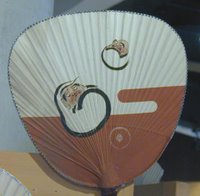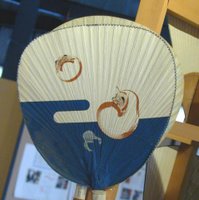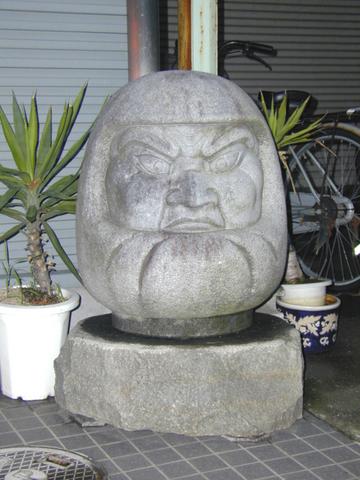:::::::::::::::::::::::::::::::::::::::::::::::::::::::::::::::::::::::::::::::::::::::::::::::::::::
Marugame City, Shikoku 丸亀
Marugame is famous for its handheld paper fans,
Marugame uchiwa 丸亀団扇 。
sensu 扇子 handfan

a cooling breeze
floats toward Tohoku -
Marugame fans
. Japan after the BIG earthquake March 11, 2011
丸亀うちわ展 Exhibition of handfans from Marugame
FUNFAN2011 in Takamatsu town
for the relief efforts in Tohoku :
. July 9, 2011 .
:::::::::::::::::::::::::::::::::::::::::::::::::::::::::::::::::::::::::::::::::::::::::::::::::::::
The Uchiwa Fan Museum at the Harbour

うちわの港ミュージアム
丸亀市港町307-15
愛称のポルカ(POLCA)は、スペイン語で「港のうちわ館」の略称です。丸亀うちわは江戸初期にこんぴら参りの土産物として始まり、京極藩が武士の内職に奨励したこともあり、丸亀の代表的な地場産業として発展を続けました。
http://www.city.marugame.lg.jp/sightseeing/spot/06.html
Look how a fan is made
http://www.city.marugame.lg.jp/sightseeing/special/1_1_1.html
Pieces of Art with Fans
http://www.city.marugame.lg.jp/sightseeing/special/1_1_2.html
:::::::::::::::::::::::::::::::::::::::::::::::::::::::::::::::::::::::::::::::::::::::::::::::::::::
Some Daruma Fans from the Museum
  |

Daruma Woodblock for Fan Printing

Inside the Fan Museum in Marugame

Stone Daruma at the roadside beside a snack bar

© Photos Gabi Greve, May 2006
:::::::::::::::::::::::::::::::::::::::::::::::::::::::::::::::::::::::::::::::::::::::::::::::::::::
Marugame Castle
丸亀城 Marugame Joo
Ikoma Chikamasa, the lord of the Sanuki area originally ruled from Takamatsu Castle. While there, he built and moved to Marugame Castle placing his son in charge of Takamatsu Castle. Marugame Castle was decomissioned as part of the one castle per country law in 1615.
Marugame Castle was resurrected in 1641 when Yamazaki Ieharu was granted the small fief of Western Sanuki. He rebuilt the castle into what we see today and developed the surrounding castle town of Marugame.
(c) Eric Obershaw 1999-2006
http://www.jcastle.info/castle/marugame.html
More photos and Japanese text
http://www.city.marugame.lg.jp/sightseeing/spot/01.html
:::::::::::::::::::::::::::::::::::::::::::::::::::::::::::::::::::::::::::::::::::::::::::::::::::::
Handheld Fan as a Summer Kigo for Haiku Oogi
:::::::::::::::::::::::::::::::::::::::::::::::::::::::::::::::::::::::::::::::::::::::::::::::::::
Detail from a fan painting

From my friend Ishino.
More fans are here !
Nr. 10 - 12, 96.
:::::::::::::::::::::::::::::::::::::::::::::::::::::::::::::::::::::::::::::::::::::::::::::::::::::

... www.utiwa.com
:::::::::::::::::::::::::::::::::::::::::::::::::::::::::::::::::::::::::::::::::::::::::::::::::::::

Fukakusa uchiwa 深草団扇
From Kyoto
. . . CLICK here for Photos !
quote
The Komaruya fan brand produced by Fukakusa Uchiwa spread throughout Japan during the peaceful Edo period (1600-1867). Kyoto was Japan's leading pilgrimage destination as most of the country's religious institutions had their headquarters in the Imperial capital. Nearly everyone who journeyed to Kyoto bought a Fukakusa Uchiwa as a memory of their trip or as a gift for people back home.
Widespread and rapid acceptance of Western ways during the Meiji period (1868-1912) had a negative impact on all kinds of traditional industries. The uchiwa fan business was no exception and Komaruya had to stop producing Fukakusa Uchiwa. However, the Komaruya tradition continued in the form of Kyo Maru uchiwa and other uchiwa styles.
source : www.kyotoguide.com . Komaruya Sumii
also hookoku uchiwa 報告団扇 with advertisements, especially made for shops or events
. . . CLICK here for Photos !

kyoomaru uchiwa 京丸団扇 usually white with red calligraphy of the names of geiko girls.
They hang at the entrance of the establishments and restaurants as a decoration.
Daruma Library
The revival of Fukakusa Uchiwa
:::::::::::::::::::::::::::::::::::::::::::::::::::::::::::::::::::::::::::::::::::::::::::::::::::::
UCHIWA うちわ
江戸初期に盛んになった丸亀のうちわづくりは、代表的な地場産業として発展を続け、現在の生産量は年間約8300万本、全国シェアの約90%を誇り、平成9年5月、国の伝統的工芸品に指定されました。
クーラーや扇風機の普及など生活様式の変化とともに、うちわの需要は昭和30年前後の最盛期に比べて減少しています。しかしながら、風情あふれるうちわは、日本の夏に欠かせない風物詩として、根強い人気を保っています。
丸亀のうちわづくりがここまで発展した理由の一つに、うちわの材料がすべて近くで間に合ったことが挙げられます。
丸亀地方では「伊予竹に土佐紙貼りてあわ(阿波)ぐれは讃岐うちわで至極(四国)涼しい」と歌い継がれています。すなわち、竹は伊予(愛媛県)、紙は土佐(高知県)、ノリは阿波(徳島県)というように、材料はすべて近くに産地がありました。交通が不便だった江戸時代にはもちろん、現在でも材料が手近に求められることは、大きい強みになっています。
うちわの町らしく、丸亀城の内堀のほとりに、この歌を刻んだ石碑もみられます。
© Marugame City
http://www.city.marugame.lg.jp/sightseeing/special/1_1.html
:::::::::::::::::::::::::::::::::::::::::::::::::::::::::::::::::::::::::::::::::::::::::::::::::::::
Alphabetical Index of the Daruma Museum
Worldkigo Database
:::::::::::::::::::::::::::::::::::::::::::::::::::::::::::::::::::::::::::::::::::::::::::::::::::::








1 comment:
Marugame Kaido 丸亀街道 Marugame Highway
Marugame was a harbour city, reached in the Edo period by pilgrims for the Konpira Shrine / Kotohira Shrine in about 3 long days on a ship from Osaka.
From the harbour it took about 14 km along the Marugame Kaido to the Shrine.
.
https://edoflourishing.blogspot.com/2019/07/awa-kaido-highway.html
.
Post a Comment